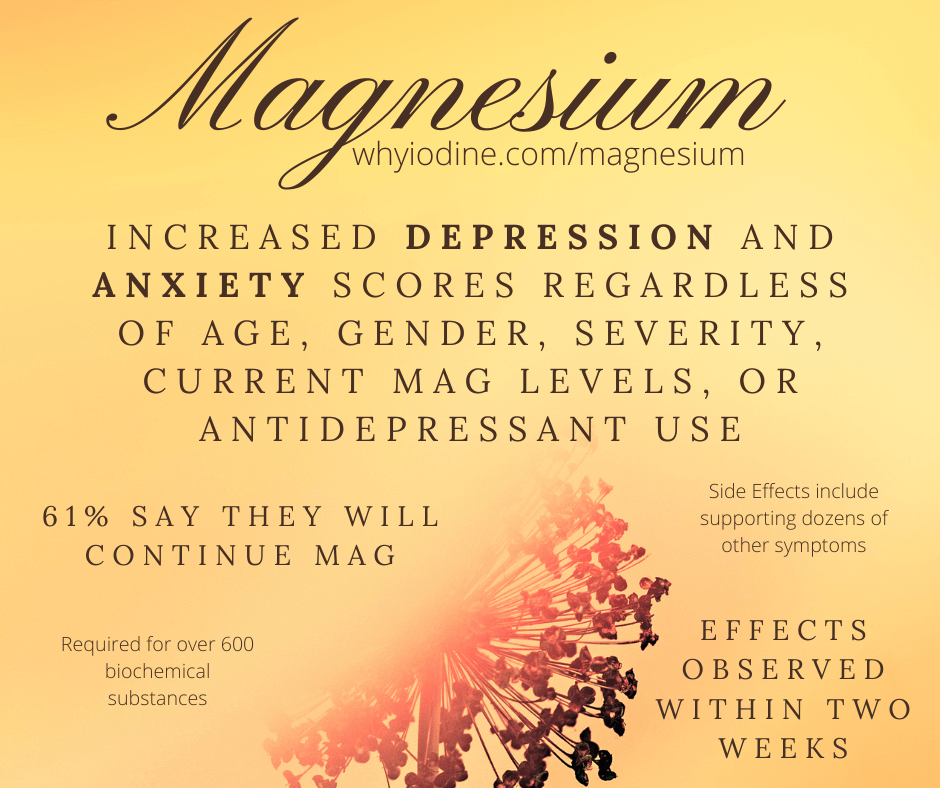A study by the National Institutes of Health found that 68% of Americans are magnesium deficient. Other experts estimate that the number is closer to 80%.
Aiming for foods high in magnesium will help us consume more nutrients in general, but we’re so far behind on some of these vital nutrients that we need to somehow boost our intake. I personally aim for as many quality sources as possible of nutrients I know my body needs.
Magnesium has connections to just about everything. Sleep, anxiety, diabetes & insulin, depression, inflammation, migraines, fibro, exercise recovery & performance, osteoporosis, restless leg and so much more.

Is magnesium safe?
Magnesium is one of the most commonly used supplements 1 which is a good indicator that it is relatively safe. I personally start new supplements very slowly and I do not take them for extended periods of time without researching them further so I know what I might be getting myself into.
Who should use magnesium?
Due to magnesium’s involvement in so many important processes, its one of the best supplements for most people to use just about as early as possible in their healing journey. A large number of our cells require magnesium similar to how a lot of food recipes require water. It’s possible that a lot of us have other nutrients on hand and just need some magnesium to allow them to function.
It’s advised to talk to our doctor anytime we start a new nutrient. If we’re taking medication it can be helpful to look into other people’s experience with magnesium supplementation with each medication.
I personally do not use a doctor and I have tried just about every supplement over the years. I just go slow and pay attention to what I’m doing. I explain this concept at whyiodine.com/pulse-dosing
Which form is best?
There are a handful of graphics and opinions about which form of magnesium is best. Although there are forms we may not want to consume in large amounts on a regular basis, each form carries its own benefits.
So why not try all of the various forms? Why limit ourselves to just one?
I think a useful and important way to look at the various forms of magnesium is as if they were nutrients of their own. We don’t know if those other nutrients will help us till we try them.
Some people are advising against certain forms because they may not be absorbed as well. But luckily we’re not looking for the highest absorption rate, we’re looking for health benefits.
Some people are sensitive to various forms of magnesium, such as citrate or malate. It’s possible this is due to the citrate itself, or it could be due to this form of magnesium actually being able to function better. Whenever a nutrient does not work well for me I pause long enough for the reaction to pass and then I try a little bit less. If I continue to feel weird from it, I wait longer and try less. If I never find a way to slowly move forward, I assume I should avoid that nutrient or form till I’m able to make progress with other nutrients and try again.
Starting magnesium supplementation
We should be eating fresh foods that have decent magnesium levels. A web search for foods with magnesium should be helpful.
An eating method called Whole 30 can be very helpful if we’re looking to eat better but aren’t sure which route to take. Join us at Whole 30 for Beginners to learn more.
As long as we are eating well and avoiding as much toxicity as possible, our cells will likely benefit by slowly increasing the amount of unrefined salt we add to our daily meals for about a month. If we have been avoiding salt we may want to go very slowly with this. If we already consume salt regularly we can try adding more or start magnesium. I share this because I think a lot of us need to “open” our cells with sodium for a bit before we can get some of these other nutrients in. Magnesium, sodium, potassium and calcium work together in a lot of ways, but we cannot use much potassium or calcium yet. As long as we are eating well we can likely make use of a lot more unrefined salt than we assume.
Similar to sprinkling salt on my food and tasting it, I open capsules of new supplements and sprinkle them in water. This way I can sip on it and gain an idea how my body is responding, just incase a lot of my cells have been waiting around for this nutrient. I can always try more in a few hours or the next day, but I cannot remove the excess if I take too much too quickly. If we are sensitive to a nutrient, its much stronger to us when we first expose our cells to it. Once our cells have had access to a bit of it, they seem to be able to handle much more in the near future.
Buying magnesium
There are a lot of brands and blends of magnesium.
My wife and I really enjoy these two
The marine based has a little calcium and the Magnesium Breakthrough has small amounts of 7 forms of magnesium.
We cycle through various forms but those two have been our main blends for a few years.
Others I’ve purchased and cycle through at times: Magnesium Malate, Magnesium Oxide, Magnesium Oxide, Citrate and Aspertate, Magnesium Gylcinate, L-Threonate, Chelated Magnesium, Magnesium Sulfate, Malate + Vitamin B6, and Seeking Health Chewable malate
Magnesium in The Iodine Protocol
Dr. Brownstein’s Iodine Protocol suggests we should get about 200-400mg per day of magnesium while taking iodine. He suggests magnesium most likely because iodine is helping increase our metabolism, which increases our demand for just about any nutrient. If we were to get a bakery running again, we’re going to increase our demand for water…
The information Dr. Brownstein is sharing is based on what worked for him while working with his clients. But he addresses outstanding issues like stomach acid or outstanding nutritional deficiencies. So we may potentially not be ready to jump into his protocol at 50mg of iodine and 200-400mg of magnesium. We may want to start with much smaller amounts of these nutrients to see how our body responds to them. I share a neat method of judging how much our cells might be able to use any nutrient here whyiodine.com/pulse-dosing
Read more about magnesium
My old page about magnesium has much more info that I plan on organizing into several shorter pages whyiodine.com/magnesiums
Continue reading…
I struggled with iodine and it’s detox for years. I have compiled this website in hopes that my journey might make yours a little easier.
Join us in the Iodine for Beginners group on Facebook
Help me help you
I’ve been compiling information about iodine since 2016.
Due to everyone being so different, and iodine being such an important part of healing, iodine requires a lot of content from a lot of different angles.
Help me reach more people by creating high quality content.
By using links to Amazon, Seeking Health, eBay, and others, funds may be generated that I can use to cover hosting and others expenses, and maybe take wifey out to dinner. Thanks in advance.
Take advantage of my coupon codes at SickofTired/save on your supplement orders.
The contents of this website, such as graphics, text, images, and other material contained on the website are for informational purposes only and do not constitute medical advice. This Site and the Content are provided on an “as is” basis.
